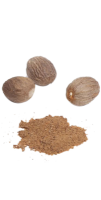Grated Nutmeg
Nutmeg – Myristica Fragrans
A collective name for a type of tree in the Myristica genus, the kind of nutmeg we see in stores and which is considered the most important one because of its high commercial value first originated on the Banda Islands (or Spice Islands) of Indonesia.
Contrary to what might be believed, the nutmeg fruit, which grows upon the nutmeg tree, is not only useful for extracting and producing nutmeg, but also mace, another type of spice. Nutmeg is actually the only tropical fruit that is the source of two different spices, nutmeg being the seed and mace being the dried covering, or arillus, of the fruit. In Grenada and Indonesia the fruit is used to make jam, the Grenadian version called “Morne Delice” and the Indonesian called “Selei buah pala”.
The history of of nutmeg in Europe dates as far back as to the Roman empire, where it is believed that the priests used to burn it as incense, later on, in medieval times, it was used as an prized flavoring in food, as medicine and as a preservative.
In Elizabethan times, it was even believed that nutmeg could aid against the plague, which further increased the popularity of this tropical fruit. Since the Banda Islands were the only source in the entire world for nutmeg, Arabs gathered and sold the fruit to European dealers but never told them where the islands were located and for a very long time the source of nutmeg were a secret to Europe.
Nutmeg is not only used as a spice, but in some parts of the world also as a recreational drug, but due to the many undesired effects due to excessive consumption of the spice, such as dizziness, dry mouth, difficulty in urination, nausea and panic, it is not a very popular choice for this purpose. The physiological and psychological effects of nutmeg usually lasts over 24 hours, making it a quite impractical recreational drug.
















.png)



























